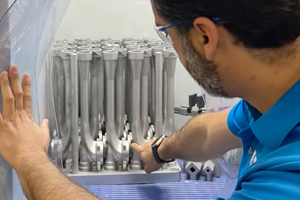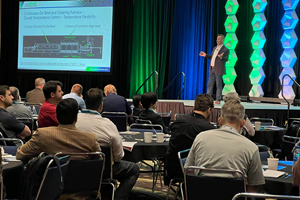Finland’s Largest Metal 3D Print Withstands Pressure Vessel Test, Vastly Exceeding Expectations
The pressure vessel was created in cooperation between Andritz Savonlinna Works and the Finish Additive Manufacturing Ecosystem (FAME), and withstood the nondestructive and destructive tests carried out by LUT University.
The shape of the approximately 300-kg pressure vessel began to give way after 80 bar in tests at LUT University. Photo Credit: Kalle Lipiäinen
Finland's largest metal 3D print (a pressure vessel ) was tested according to the pressure vessel standard EN 13445-3 and withstood 111 bars in the tests – exceeding expectations many times over. The pressure vessel created in cooperation between Andritz Savonlinna Works and the Finish Additive Manufacturing Ecosystem (FAME) withstood the nondestructive and destructive tests carried out by LUT University better than expected. In the tests, the pressure was increased until the piece started to break. This happened at a pressure of 111 bar.
“This vessel was designed for an operating pressure of 10 bar, which includes the safety factors. The preliminary calculation showed that the rupture would occur at around 90 bar, i.e. the actual durability far exceeded expectations,” says Santeri Varis, additive manufacturing manager at Andritz Savonlinna Works. “It must be noted that in real production pieces, the test pressure of the pressure vessel is usually only done at around 1.5 times the operating pressure, i.e., in this case the test pressure would have been only 15 bars."
It was known in advance that the quality of the method used on a small scale is good, but there was no experience with such a large scale. “I was surprised by such a high result, and it certainly strengthened my belief in the good quality of WAAM,” Varis adds.
The approximately 300-kg pressure vessel is manufactured with Andritz Savonlinna Works’s equipment, whose operating principle is directed energy deposition-arc (DED-Arc) as an energy source. Colloquially, the method is known by the abbreviation WAAM (Wire Arc Additive Manufacturing). Made of acid-resistant stainless steel (316 L), the approximately 300-kg pressure vessel has a diameter of 900 mm and a height of 1,600 mm. Elomatic has also been involved in its design phase.
The pressure vessel has been tested in many ways. First, it underwent nondestructive testing (NDT) with penetrant. LUT University’s experiments tested its material and geometry-based performance. The finished part was compared with, among other things, the CAD model, which it matched at best with an accuracy of two millimeters on average, which is a very good result and is practically explained by the width of the printed weld.
In the pressure test, water was pumped into the vessel and monitored for what changes it causes in the diameter of the widest part of the vessel. The pressure was gradually increased at first and finally to the maximum.
“Under 66 bars, there were still no noticeable changes in the vessel. The shape started to give way after 80 bars,” says Kalle Lipiäinen, a doctoral researcher at LUT University. “We continued the test so long that some water leaked out of the vessel at 111 bars. At that point, a small crack appeared next to the legs of the vessel. The diameter had expanded by 7%. The result is very good for a piece like this, which is designed to withstand much lower pressure."
The crack was welded and in the next test there was a fracture right at the leg again. This indicated that the leg area was a structural weak point, and the first breakdown was not due to, for example, a manufacturing error.
There is now information about the use of WAAM in large pieces that was not available before. The FAME Ecosystem distributes information to companies and LUT publishes scientific articles on the subject. “We learned a lot from the testing process. It would be great if there were more opportunities to carry out tests of large 3D printed parts and hybrid structures,” Lipiäinen says.
The team says the test results show skeptics that high-quality pieces can be made with 3D printing if you know what to do and understand the design and manufacturing process. “Now it's just a question of companies’ ability to adapt new technology into their own manufacturing processes, because otherwise there’s a risk of falling behind competitors,” says Eetu Holstein, FAME lead from DIMECC.
In Finland, many companies in the metal industry already have all the prerequisites needed to manufacture their own 3D printed pressure equipment and other products because the printing equipment needed for WAAM basically consists of a robotic welding cell and a robotic welding power source.
However, a 3D-printed pressure vessel will not immediately appear on the market. The reason for that is standardization. Pressure vessels must meet the pressure equipment directives and EN standardization is at the stage in which the working group has been established. This means that in a few years there may be standards for design and production. While waiting for that, the process and testing can be refined.
In the printing of the pressure vessel, the arc time was about 100 hours, but the actual production time, including cooling, inspections and measurements, and learning, was about 300 hours. More than three km of welds were consumed in the pressure vessel. At its best, the printing speed was 4 kg/hr.
The team says testing of the Finnish skill sample has attracted international interest, so the pressure vessel and the results will be presented in Frankfurt at Formnext.
“In Finland, we have enormously good expertise in the design, manufacture and testing of 3D prints. We are able to stand out in the world as experts in particularly demanding 3D prints, which means demanding designs and applications as well as the ability to print rarer materials. We are trying to bring this message to the attention of people both in Finland and abroad,” Holstein says.
- Learn more about Wire Arc Additive Manufacturing (WAAM) by checking out the WAAM section of our website.
- Read about some of the latest large-format successes in additive manufacturing.
Related Content
5 Big Themes in Additive Manufacturing at Formnext Forum: Austin
Formnext Forum: Austin, a two-day event at the end of August focused on additive manufacturing for production, includes a conference exploring important ideas in AM related to supply chains, bridge production, enterprise transformation and more.
Read MoreCopper, New Metal Printing Processes, Upgrades Based on Software and More from Formnext 2023: AM Radio #46
Formnext 2023 showed that additive manufacturing may be maturing, but it is certainly not stagnant. In this episode, we dive into observations around technology enhancements, new processes and materials, robots, sustainability and more trends from the show.
Read MoreThe Additive Manufacturing Conference Is Becoming the Formnext Forum
The 2023 Formnext Forum takes place in Austin, Texas, and absorbs the event previously known as the Additive Manufacturing Conference.
Read MoreArburg Freeformer 750-3X 3D Features Larger Build Chamber
Formnext 2022: The Freeformer 750-3X 3D provides more space inside the build chamber for larger components.
Read MoreRead Next
At General Atomics, Do Unmanned Aerial Systems Reveal the Future of Aircraft Manufacturing?
The maker of the Predator and SkyGuardian remote aircraft can implement additive manufacturing more rapidly and widely than the makers of other types of planes. The role of 3D printing in current and future UAS components hints at how far AM can go to save cost and time in aircraft production and design.
Read MoreHybrid Additive Manufacturing Machine Tools Continue to Make Gains (Includes Video)
The hybrid machine tool is an idea that continues to advance. Two important developments of recent years expand the possibilities for this platform.
Read More3D Printing Brings Sustainability, Accessibility to Glass Manufacturing
Australian startup Maple Glass Printing has developed a process for extruding glass into artwork, lab implements and architectural elements. Along the way, the company has also found more efficient ways of recycling this material.
Read More






















